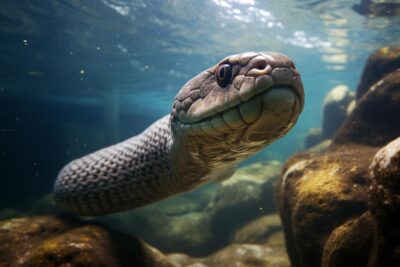Do you know those sleek and slithery sea snakes that glide through the ocean like they own the place? Well, I’ve got a mind-boggling question for you: Can sea snakes breathe underwater? It’s one of those things that sound straight out of a deep-sea mystery novel, but these oceanic serpents have some seriously cool tricks up their scales that let them pull off the underwater breathing act.
No, sea snakes cannot breathe underwater. Despite their aquatic lifestyle, sea snakes are air-breathing reptiles that need to come to the water’s surface to breathe. They have evolved specialized respiratory adaptations, including buccal pumping, to efficiently exchange gases and replenish oxygen while submerged.
This allows them to spend extended periods in water, but they still rely on access to the air at the surface for respiration.
Unique adaptations of sea snakes to aquatic life

Sea snakes are highly adapted to their aquatic environment, displaying a range of unique features that distinguish them from their terrestrial relatives. Here are some notable adaptations of sea snakes to life in the water:
- Oar-like Tail: Sea snakes have a flattened, paddle-shaped tail that acts like an oar, providing efficient propulsion through the water. This adaptation is crucial for their marine lifestyle, helping them move swiftly and navigate effectively.
- Valve-like Nostrils: Sea snakes have specialized nostrils with a valve-like structure that allows them to close their nostrils when submerged. This adaptation prevents water from entering their respiratory system while swimming or hunting underwater.
- Reduced Ventilation: Sea snakes have a reduced need for breathing compared to their terrestrial counterparts. They can hold their breath for extended periods, with some species capable of staying submerged for several hours. This ability is facilitated by efficient gas exchange in their lungs.
- Salt Glands: Sea snakes have specialized salt glands located near their nostrils that help them excrete excess salt from their bodies. This adaptation is crucial for maintaining the proper balance of salt in their systems, as they live in a saline environment.
- Venomous Fangs: Many sea snakes are venomous, equipped with fangs at the front of their mouths. Their venom is primarily used for subduing and immobilizing prey. While sea snake venom can be potent, they are generally not aggressive toward humans unless provoked.
- Eel-like Body: Sea snakes have a streamlined, elongated body that resembles that of eels. This body shape minimizes water resistance, making them well-suited for efficient swimming. The flattened tail, combined with the sleek body, contributes to their hydrodynamic design.
- Large Lungs: Sea snakes possess large lungs relative to their body size, allowing for increased oxygen storage. This adaptation helps them survive in environments where oxygen levels may fluctuate, especially during deep dives.
- Live Birth: Unlike many other snakes, most sea snakes give birth to live young rather than laying eggs. This adaptation is advantageous in the marine environment, as it eliminates the need for nests and protects the offspring from terrestrial predators.
These adaptations collectively enable sea snakes to thrive in the challenging conditions of the ocean, where they have successfully carved out a niche as specialized and highly efficient marine reptiles.
Can sea snakes breathe underwater?
No, sea snakes cannot breathe underwater. Like other reptiles, sea snakes are air-breathing animals. They have lungs and need to come to the water’s surface periodically to breathe. Sea snakes have adapted to their aquatic lifestyle by utilizing a specialized respiratory mechanism known as buccal pumping, allowing them to efficiently exchange gases while swimming near the water’s surface.
This adaptation enables them to thrive in marine environments while maintaining their dependence on air for respiration.
- Valve-like Nostrils: Sea snakes have specialized nostrils equipped with a valve-like structure that allows them to close their nostrils when submerged. This adaptation helps prevent water from entering their respiratory system while swimming or hunting underwater.
- Reduced Dependence on Surface Breathing: Sea snakes can hold their breath for extended periods, ranging from a few minutes to several hours, depending on the species. This ability is facilitated by efficient gas exchange in their lungs and a reduced need for frequent surfacing to breathe.
- Efficient Oxygen Storage: Sea snakes have relatively large lungs compared to their body size, allowing for increased oxygen storage. This enables them to extract and utilize oxygen more efficiently, contributing to their ability to stay submerged for extended periods.
Despite these adaptations, sea snakes must eventually come to the surface to breathe air. They are known to rest on the water’s surface or among floating debris, exposing their nostrils for breathing. The duration of time a sea snake can spend underwater varies among species, and some are more adapted to prolonged dives than others.
Also, you need to know that sea snakes, like all reptiles, are air-breathing animals, and while they have impressive adaptations for an aquatic lifestyle, they are not capable of extracting oxygen directly from the water like fish or other aquatic organisms.
Respiratory System of Sea Snakes

The respiratory system of sea snakes is adapted to their semi-aquatic lifestyle, allowing them to efficiently exchange gases while spending a significant amount of time underwater. Here are some key features of the respiratory system of sea snakes:
- Lungs: Sea snakes have well-developed lungs that allow them to breathe air. These lungs are relatively large compared to their body size, enabling efficient oxygen storage. The increased lung capacity is crucial for extended dives and reduces the frequency with which sea snakes need to come to the surface to breathe.
- Valve-like Nostrils: Sea snakes have specialized nostrils with a valve-like structure. This adaptation enables them to close their nostrils tightly when submerged, preventing water from entering their respiratory passages. The valve-like nostrils play a vital role in maintaining a sealed airway during underwater activities.
- Efficient Gas Exchange: Sea snakes are capable of efficient gas exchange in their lungs. This efficiency allows them to extract oxygen from the air they breathe more effectively, supporting their ability to stay submerged for extended periods.
- Reduced Ventilation Rate: Sea snakes exhibit a reduced need for ventilation compared to their terrestrial counterparts. They can hold their breath for varying durations, ranging from a few minutes to several hours, depending on the species. This reduced ventilation rate helps conserve energy and allows them to navigate underwater environments more effectively.
- Salt Glands: While not directly related to respiration, sea snakes have salt glands near their nostrils. These glands play a role in excreting excess salt that sea snakes may accumulate from their marine environment. Maintaining the proper balance of salt in their bodies is crucial for overall physiological function, including respiratory processes.
How sea snakes use buccal pumping for respiration
Sea snakes, like other reptiles, breathe air and possess lungs for respiration. However, sea snakes have adapted to their aquatic lifestyle, and their respiratory system includes a specialized mechanism called buccal pumping to facilitate breathing while swimming.
Buccal pumping is a method of respiration where an animal uses its mouth and throat muscles to actively pump air into its respiratory system. Sea snakes, being air-breathing reptiles, need to come to the water’s surface periodically to breathe. Here’s how sea snakes use buccal pumping for respiration:
- Surface Breathing: Sea snakes spend a considerable amount of time swimming near the water’s surface. When they need to breathe, they raise their heads above the water and open their mouths.
- Inhalation: To inhale air, the sea snake quickly opens its mouth and expands its throat. This creates a low-pressure area, causing water to rush into the mouth. At the same time, the snake may also use its nostrils, which are located on the top of its head and can be closed to prevent water from entering.
- Buccal Pumping: After the mouth is filled with air, the sea snake closes its mouth and contracts its throat muscles. This action forces the air from the mouth into the lungs. The snake then opens its glottis (the opening between the vocal cords), allowing air to pass into the respiratory system.
- Exhalation: The sea snake then closes its glottis and contracts its body muscles, increasing the pressure in the lungs. This forces the used air out of the lungs and back into the mouth.
- Nostril Use: As the sea snake continues swimming, it may expel the used air through its nostrils while still submerged, ensuring that the respiratory process is efficient.
By employing buccal pumping, sea snakes can efficiently exchange gases (oxygen and carbon dioxide) at the water’s surface without the need to fully surface or expose themselves to potential predators for extended periods. This adaptation allows them to thrive in their aquatic environments while maintaining their dependence on air for respiration.

Importance of Sea Snakes’ Respiratory Adaptations
The respiratory adaptations of sea snakes are crucial for their survival in the marine environment. These adaptations allow sea snakes to efficiently obtain oxygen from the air while spending a significant amount of time in water. Here are some key aspects highlighting the importance of sea snakes’ respiratory adaptations:
- Aquatic Lifestyle: Sea snakes are highly adapted to life in water, and their respiratory system allows them to breathe air while submerged. Unlike fish, which extract oxygen directly from water through gills, sea snakes are air-breathing reptiles that need to come to the surface to breathe.
- Buccal Pumping Efficiency: The buccal pumping mechanism is an efficient way for sea snakes to exchange gases. By using their mouth and throat muscles to actively pump air, sea snakes can quickly replenish oxygen levels and eliminate carbon dioxide. This adaptation allows them to stay submerged for extended periods without the need for frequent surfacing.
- Surface Breathing: Sea snakes spend a significant amount of time swimming near the water’s surface. Their ability to raise their heads above the water and efficiently perform buccal pumping enables them to breathe without fully surfacing, reducing the risk of predation.
- Nostril Function: The placement and function of the nostrils on the top of their heads are also essential. Sea snakes can close their nostrils when submerged, preventing water from entering the respiratory system. This adaptation is crucial for maintaining the integrity of the air exchange process.
- Predator Avoidance: The ability to perform buccal pumping and surface breathing without fully exposing themselves to potential predators is a significant advantage for sea snakes. This reduces the time they spend at the water’s surface, minimizing the risk of predation from birds, larger fish, or other marine animals.
- Efficient Gas Exchange: The respiratory adaptations of sea snakes ensure efficient gas exchange between the air and the bloodstream. This is vital for delivering oxygen to tissues and organs and removing carbon dioxide, supporting the metabolic demands of an active marine lifestyle.
- Temperature Regulation: Sea snakes are ectothermic, meaning they rely on external sources to regulate their body temperature. The efficient respiratory system helps them manage oxygen consumption and metabolic heat production, contributing to their overall thermoregulation.
Conclusion
On this page, you can get to learn more on the question can sea snakes breathe underwater. No, sea snakes cannot breathe underwater in the same way fish do through gills. Sea snakes are air-breathing reptiles, and they need to come to the water’s surface periodically to breathe.
Their respiratory adaptations, including buccal pumping and specialized nostril function, allow them to efficiently exchange gases while submerged, enabling them to thrive in their aquatic environments.

